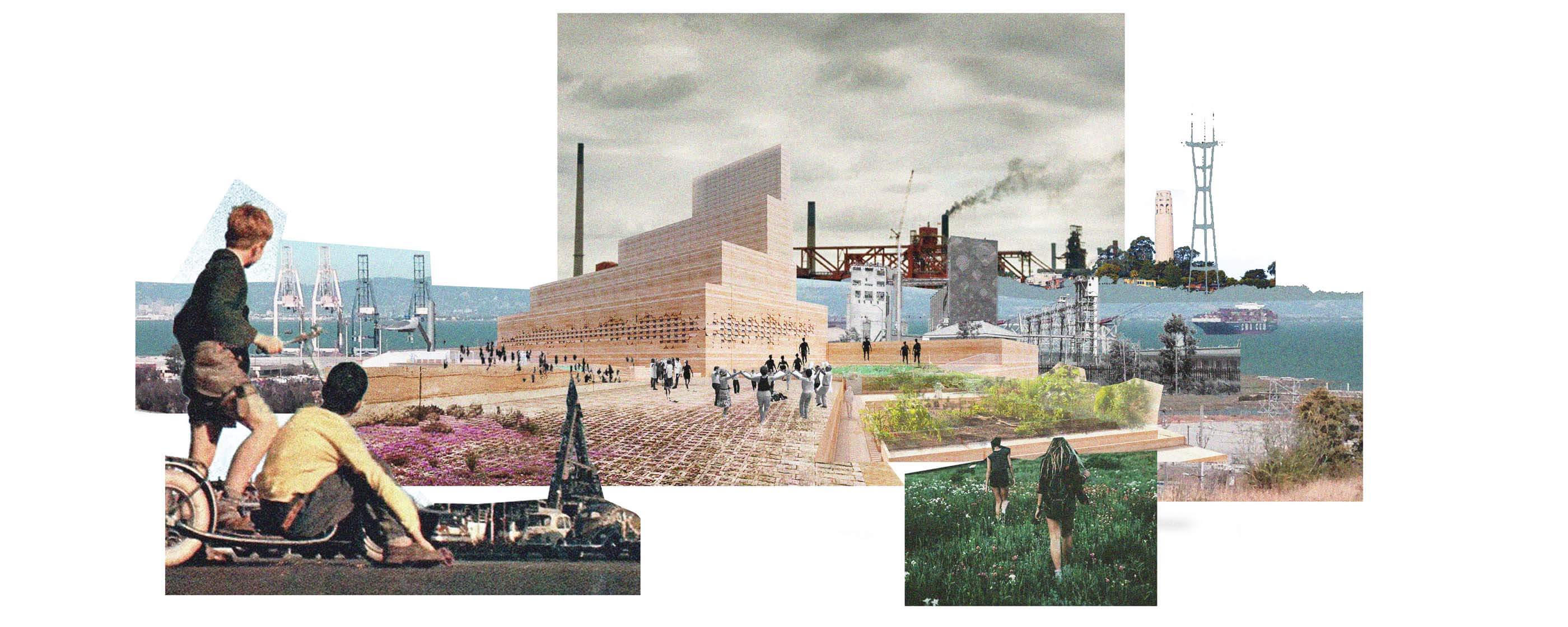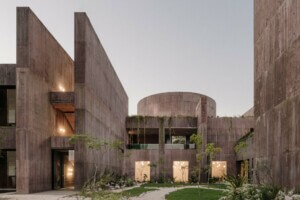A new proposal by Mexico City–based firm Tatiana Bilbao Estudio and San Francisco–based studio TEF Design will overhaul the site of a former power plant in San Francisco’s Hunters Point neighborhood, adding a three-story electricity substation and a number of public amenities.
The 800,000-square-foot lot at the intersection of Evans Avenue and Jennings Street has seen a lot over the last century. Pacific Gas and Electric Company (PG&E) first opened a power plant in 1929 as an oil-burning facility with boilers, smoke stacks, and massive tanks for storing fuel. In its 77 years of operation as an electricity and heat provider to the city, it was deemed one of the “oldest and dirtiest power plants” in California. Its emissions proved to be detrimental to the surrounding neighborhood, an area abutting the India Basin used for shipbuilding and cargo operations in the early 20th century. Health studies of residents in the 1990s revealed increased rates of chronic illnesses and medical conditions, including asthma, congestive heart failure, and cancer—all unfortunate consequences of decades of pollution.
Local advocacy groups formed and demanded the plant’s closure; the City of San Francisco promised it would shut down operations once a viable power alternative was confirmed. The fight continued until 2006, when PG&E finally complied and closed the plant, leaving behind an abandoned, post-industrial wasteland. Cleanup spanned nearly two decades, a community effort aided by PG&E. The cleanup marked a new chapter for the local community, as it brought the neighborhood together and was an opportunity for the utility company to right past wrongs. This process ultimately established a pathway for the new redevelopment plan by Tatiana Bilbao Estudio (TBE) and TEF Design, which will transform the site into a bustling public space, with a 30,000-square-foot substation as the centerpoint.

In a remarkable improvement from the imposing, industrial menace that once loomed over local residents, the three-tiered, glowing rammed earth–like structure will not only house electrical utilities but will also serve as a community landmark, with a plaza and community gardens.
The history of the site and the local community’s ongoing efforts to promote environmental justice was central to the project. Tatiana Bilbao built on this when it came to the design of the substation; for the Mexican architect, designing the new substation was an opportunity to continue the restorative relationship between PG&E and the local neighborhood.
“The closure of PG&E’s outdated power plant in 2006—which rid the neighborhood of its emissions—and the site’s subsequent clean-up to residential standards was the major environmental justice achievement,” Bilbao told AN.
Community discussions for the design of the substation began as early as 2017, when TBE and TEF worked with design consulting firm urb-in to gather feedback at community and stakeholder meetings, and continued through extensive digital outreach and an online opinion survey. Bilbao and her team were able to incorporate amenities that met the community’s wants (and needs), including ample seating, areas for farmer market stalls, an all-gender restroom, and a kiosk for food service.
“Collaboration with the community also manifested the importance of sustained engagement around issues of representation, equity, and environmental justice. The design team has continued proactive neighborhood engagement throughout the permitting, and now, the construction process to support a working, positive relationship with community stakeholders,” added Jonathan Manzo, owner and founder of urb-in.
This wasn’t Bilbao’s first time working on a project in Hunters Point. The firm previously designed a masterplan for Hunters Point at large; the neighborhood, beyond the power plant, also supported a former naval shipyard, an operation that introduced lethal chemicals into the soil, including asbestos. Though unbuilt, Bilbao said that working on the masterplan was essential in how her team approached the substation. The project helped the team understand the site’s complicated past. The resulting representation—drawings and models—was a major part of Architecture From Outside In, an exhibition of Bilbao’s work recently installed at the San Francisco Museum of Modern Art.

“[The masterplan] laid the groundwork for cultivating trust and a new relationship between the community and PG&E after decades of adversarial conflict,” Bilbao explained. “We were able to build upon the empowerment that they brought to the community and benefit the substation through authentic collaboration with neighborhood stakeholders.”
Collaborating firm TEF also has previous experience working in the area and with PG&E. The goal for the new substation to reach net-zero energy was ambitious, but by no means out of reach; TEF Design had an existing model for net-zero energy utility infrastructure to work off of, the Larkin Substation, a nearby facility also developed for PG&E. Located about 5 miles north of the Hunters Point site, Larkin is the first electrical switchgear building in the U.S. targeted by the International Living Future Institute’s (ILFI) Zero Energy Building Certification of the Living Building Challenge. While Larkin stands out as a technical feat, TEF also made sure not to neglect architectural and aesthetic considerations, as evidenced by the substation’s ethereal facade.
At Hunters Point, the proposed design also maximizes thermal efficiency by drawing from computational fluid dynamics and strives to target net-zero energy (NZE). It will incorporate photovoltaics, natural ventilation, and other efficient building systems to achieve Zero Energy Certification by the ILFI.
“In addition to its iconic expression as a community landmark, its form and configuration exploit the city’s temperate climate to address equipment cooling requirements, while maximum use of energy-efficient technologies and on-site solar generation contribute to the project’s NZE-targeted rating,” TEF Principal Paul Cooper said. “The building’s massing, expression, and materiality, and its neighborhood-serving plaza establish a rich new urban edifice and public amenity in an area long ignored by investment.”
Brighter (and cleaner) days may be ahead for Hunters Point, a neighborhood that, in addition to the problems of pollution, poverty, and crime, now faces gentrification.The design proposal offers an alternative energy source but also an alternative future, one led by the community it serves. Project completion is estimated for fall 2023.
“Environmental justice is fundamental to the project, the site, and the area’s history,” Bilbao said. “Our goal was to reinforce and advance this front in the community, not only by minimizing the substation’s impact on our planet, but more importantly, by placemaking that provides value for the people, as opposed to real estate value. We can craft a net-zero energy building, but if the community is expelled due to gentrification, that’s not justice.”











